Age of Discovery II: The Heart of the Multiplayer
By gamer_152 1 Comments
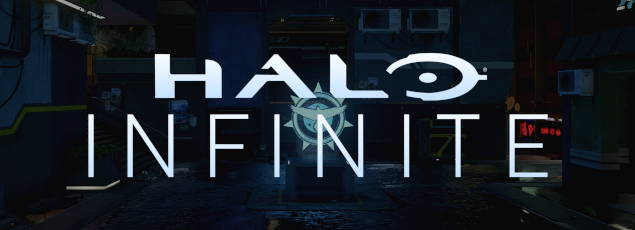
Last week, I used this blog to digest Halo Infinite's Campaign mode. It stands tall on the jigsaw-perfect interlocking of Halo's gunplay and enemy design, and is bolstered by a liberating new grapple. It's also less than the sum of its parts, with the core combat unmoored from and undercut by a generic open-world shell. The packaging of the multiplayer might be even more of a trainwreck. Yet, in the sacred space of the online, the meta-systems don't encroach as much on the core experience as they do in the Campaign. And I can't tell you how thankful I am for that because the heated competition at the heart of Infinite's multiplayer is phenomenal.
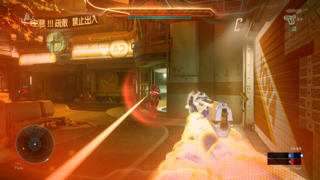
Some background: Up until now, Halo has been driven by a steady aiming model and a relatively long gap between when you first engage enemies and when you can fire off the crucial shot that kills them. Halo's extended engagement window meant that players were less likely to earn a kill by the dumb luck of being in the right place at the right time. A combatant under fire generally had enough pause and information to realise their plight and then outrun or challenge the enemy. The hunter who wanted to bag their kill had to be proficient enough to chase down their evading target or outgun them face-to-face. That hesitant pacing existed in contrast to the frenetic chaos of the gory arena shooters of the 90s and the self-serious modern military excursions of the 00s and 10s.
When snagging your prey, the Assault Rifle proved invaluable. Becoming somewhat of a mascot for the series, this machine gun was inaccurate, but its high-fire rate could grind down the shields of anyone engaging you at short to mid-range. For other opponents in the mid-distance and those closer to the horizon, there were the precision weapons like the Magnum or Battle Rifle. Killing your opponent with one of these doombringers was a matter of staring them down over the barrel, trying to pop off as many headshots as possible. As a rule, players spawned with the Assault Rifle and a precision weapon, although these days, Halo 5's ranked league shoves you out of the door with just a pistol for company. The designers recognise that having only a peashooter to hand rigorously tests your aim.
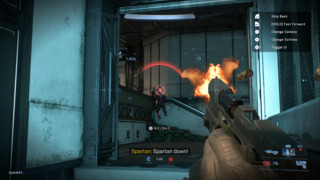
Infinite scatters the methodology of previous Halos to the wind, including those of the gunplay. The new firearms are composed of lighter metal, no longer fixing tightly on targets but drifting around fluid in your palms. With a flightier aim, fewer of your shots are going to penetrate enemy armour, so the game compensates by making rival Spartans weaker than ever before. After years of swearing it off, the series has come around to the idea that feline fast combat is the way of the future. Your newly downsized health pool means you can sometimes find yourself a limp corpse, collapsing to the floor before you even know an enemy's on your tail. It stinks of unfairness, and is compounded by the Ranked Arena having no radar and even Social modes restricting their motion trackers to an eighteen-metre radius.
In a perfect world, players who find their electronic senses impaired would be more communicative. When the UI doesn't watch your back, your siblings in arms have to. Of course, not that many people are hooking up a mic to their PC or Xbox, and I can't blame them. A headset is one more accessory on the debit card, and discourse on Xbox LIVE has a reputation for being, let's call it, "contentious". Infinite accounts for this silence on the airwaves using a tagging system. With one tap of the D-Pad, you can paint a flare on the map for all your team to see and a tidbit about what you've selected in the sidebar. Your entry on the battle log will read something like "2 Enemies at Turbine" or "Banshee at South Base". This environmental graffiti lacks the precision and suppleness of voice communication, and a prominent glitch often truncates the locations of items and enemies from the battle records.
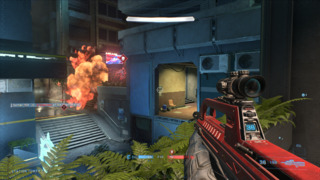
Still, with mic'd up players few and far between, orderly communication is a skill that most Halo players haven't been able to indulge in developing. With these electronic callouts, 343 are opening up information exchange between many players for the first time. Under Mjolnir's old ESP, the player passively absorbed the location of enemies; with the tags, users perform as antennae, taking an active role in relaying the state of the battlefield. When they decide they want to, that is. Most Spartans don't dedicate any mental RAM to keeping their team in the loop. Still, to my mind, the tagging system has the trademark of any good mechanic: when I played other games that didn't replicate the feature, I missed it.
Of course, the primary consequence of Halo's remixing is not in how you communicate with your squad but in how you put crosshairs over bodies. Movement and aiming reside in the kernel of any shooter, so when you change them, you change everything: the weaponry, the maps, the powerups, etc. Tampering with the core of a beloved game is not for the faint of heart; you could break everything. But you could also revolutionise the title and give the audience a whole new knife on which to sharpen their teeth. 343 has miraculously pulled off the latter.
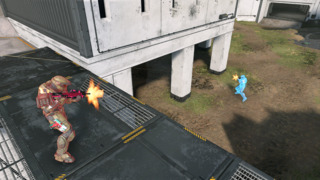
With less player health to whittle down and precision weapons more unwieldy than ever, those bullet hoses that would once have shot too wide have found new life. And the mainstay technique of headshotting your opponents to death with a sidearm is a thing of the past; it would take a William Tell to pull it off consistently. Now, even players who fancy themselves part of the esports scene will go in Assault Rifle blaring as, for the first time, it holds its own in long-range. Meanwhile, the new pistol, the Sidekick, is more for pulverising an enemy's body than blasting open skulls. At least, on Xbox. As the revised aiming speed splits the difference between measured gun movement and twitch reflexes, Infinite, more than any other Halo, accommodates both PC geeks and console warriors.
Weapons that would have been considered overpowered in previous Halos also now find a space in the rack. Their advantages are offset by the difficulty of training them on a target. Take, for example, the Shock Rifle: this is a precision firearm with a lower DPS than most guns of its stripe, but it delivers fatal headshots. Aspiring Zeuses can also chain its electrical arcs between enemies closely clustering together.
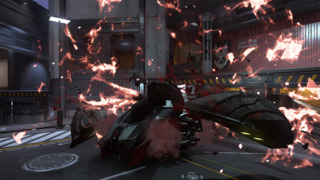
In Halo 5, a chameleon that morphs back and forth between AoE tool and sniper would have destroyed any semblance of balance. However, when the player is less likely to hit the bullseye with it, the developers can incorporate it without risking the weapon selection becoming too top-heavy. It is this same tradeoff that makes the Skewer viable. This shoulder-mounted ballista can rip through vehicles and insta-kill Spartans even without connecting with their cranium. Its one-spike magazine offsets those titanic powers. However, more moderating is that the aiming model makes it a bastard to score a direct hit with.
Previous Halo games would often wrangle up a mix of original armaments and tweaks on old favourites. A new entry could inaugurate both a Grenade Launcher whose rounds you must bounce off the floor and a permutation of the Battle Rifle that fired one round instead of three. Infinite seethes at this idea of slight degrees of separation between the weapons. It wants almost all of them to earn their place on the podium not just by varying in fire rate or bloom, but in the mechanics they function by and the protocols of their operation. The Skewer and Shock Rifle are two examples of this design philosophy, as is the omission of the DMR, Covenant Carbine, and LightRifle: all plays on the Battle Rifle. You won't have to look hard to find a Sniper Rifle, but never will you see its Beam or Binary variants on this runway, jacking its style.
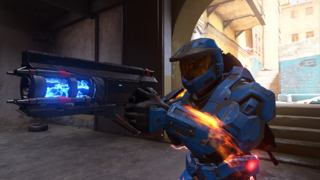
There's a strong case to be made that elder Halo's close-knit families of weapons created a nuance between the tools that only became more appreciable the more you played. Still, Infinite's overhaul of the armoury is another welcome refashioning of everything Halo. There are too many new curios on its shelves for me to document them all. However, consider the Disruptor: a repeater pistol that drains the target's shield and health, even once they're out of its line of fire, and which extends the delay before the victim's shield can recharge. The intrepid soldier can also use it to EMP vehicles. If this electrical sidearm is to your tastes, you relish your moments with it and are never lukewarm on procuring it because it has no equivalent.
Or take the Cindershot, whose indiscriminate explosives ricochet off walls like Superballs. You can either use it as a fire-and-forget missile launcher or guide its shots after they've left the barrel. If this hardlight hellion isn't your speed, there's the Commando, which demolishes the barrier between automatic and precision weapons, or the Heatwave, which spits a sheet of projectiles in a different pattern depending on the mode you've set it to. There's so much imagination swirling beneath the surface of this game, and that the developers got so creative in sketching out the guns inspires me to get creative in implementing their work.
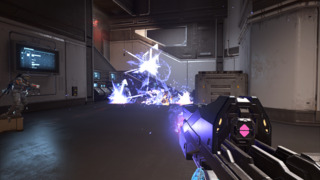
You may have noticed another theme connecting these party poppers: they often have more than one application. The Cindershot can disintegrate anyone sitting in a confined space on its "regular" setting or become a precision power weapon when you remote control its fireworks. The Disruptor can be your best friend in crippling Spartans or in paralysing vehicles. The essences of two guns are often collapsed into one, giving you fascinating choices in how you kneed them into your strategy. This multi-faceted nature is only more pronounced in the game's equipment.
Equipment consists of single-use items that players can pick up from the battlefield. They hail from Halo 3, in which every deployment of them was a little different. You'd always install them in another part of the map with the players and weapons in a unique state. Still, within each context, there were only one or two roles for each piece of equipment to take: the Regenerator restored defences, the Flare blinded belligerents, the Power Drain could sap shields or disable vehicles' engines, etc. In Reach and 4, the equipment was usurped by loadout abilities like Jet Pack or Hologram, which were often made for more varied fare, but performed the same action with each button press.
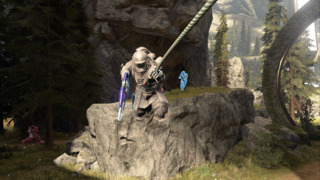
I'm the last guy who's going to rag on the Jet Pack, but the truth remains that Infinite is mind-boggling in how many more jobs it finds for each pick-up. Let's drop in on the Grappleshot again. Obviously, being able to pull yourself up or across an environment has practical applications just about anywhere. Yet, the Grappleshot isn't just an adaptable mode of travel. You can also use it to nullify the distance between you and an opponent, allowing you to thrash them with a close-range jab. It's also a first-rate implement for boarding and hijacking vehicles, especially useful when your foe is buzzing about in an aerial craft. You can even take advantage of it to yank power weapons, equipment, flags, or oddballs off of the field without the danger inherent in running right up to them.
The opposite of the Grappleshot is the Repulsor. With a defiant burst of gravity, this arm guard blows back whoever or whatever stands in your way. If that's a Spartan, they'll also be stunned for a split-second. With it, you can stagger a player bearing down on you or put some distance between yourself and any pests trying to engage in CQC. It can stop an automobile dead in its tracks and maybe even overturn it. You can also eliminate an enemy by propelling them into a wall or off the map with the Repulsor.
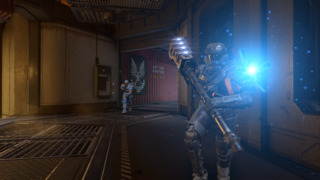
When I first found the Threat Sensor, I didn't see the horizonless applications for it that I found with the Grappleshot or Repulsor: you fire it at a hard surface, and if a foe wanders into its all-seeing gaze, they light up for everyone on your team to see. What more is there to it than marking enemies? But its broad utility becomes obvious once you start thinking outside the box. The Threat Sensor not only allows you to put opponents on blast, but as it promises to paint a target on their back, you might be able to get them to avoid a certain zone entirely. Affix it to an ally's gun, and they become a roaming recon unit; you can even build your own radar van by attaching it to an allied transport. Slap the same equipment on an enemy vehicle, and you'll always be able to locate their Wasp or Warthog.
The Drop Wall and Thrusters aren't as malleable but still cover a wide variety of combat encounters. The Thrusters are in the same line of work that they were in Halo 5: they let you flinch backwards or dart around a corner should an adversary get the drop on you, reducing the randomness of enemy success. Like the Grappleshot, you can also use them to invade a foe's personal space with something heavy or sharp. The Drop Wall is analogous to Halo 3's Bubble Shield, but the Bubble Shield surrounded the player, and no rounds could enter or leave that dome. This hologram fortress basically trumped a player without a short-range weapon, and its ceasefires tended to create anti-climaxes in battles.
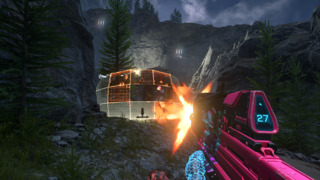
The Drop Wall blocks fire from directly in front of the player while still allowing them to shoot through the reverse side. It does not stop the bullets from flying, and the opponent can continue to get a bead on their target; they just have to work harder for it, skirting around the partition. When an attacker does plug away at this screen, it disappears in panels rather than all at once. The defender must make informed choices about whether to occupy a shrinking safe zone or make a break for more favourable cover.
The game even fixes the most glaring shortcoming of Halo 5's Ranked Arena: the Overshield is no longer a license to make clumsy, illogical moves and see the damage done to you melt away. You must now manually equip the powerup at will, and the shield boost you receive from it dissipates rapidly. There's an onus on you to carefully calculate the window in which it will provide you with much-needed protection.
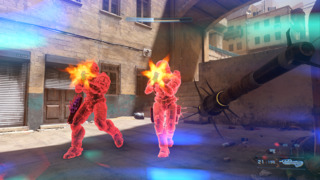
Grenade-wise, the Frags and Plasmas basically function as you've always known them, which is to say they're perfect. The Spike Grenade from Halo 3 makes a return, but where it was previously a variation on the Plasma Grenade, now it's something far more individual. You could use it to impale an enemy, but it also serves as a time bomb that you can stick to anything solid. When it detonates, it ejects its pointy payload in a roughly straight line. It's a delicious ploy to lure an enemy into this trap. If I still haven't piqued your interest, let me leave you with this: the Dynamo Grenade, a grenade that chases its targets like your own loyal guard dog. This might go without saying, but the weapons, grenades, and equipment are every bit as snappy and impactful as those from Halos past.
A live service game that needs to fill not months, but years, of the user's life must have a whole country of play for them to trek. A lot of experiences fall into the trap of thinking the trick to get there is senselessly churning out more content. Infinite understands the real solution is in giving the player new skills to learn and forging core play elements that stand up to endless repetition. Each of Infinite's multiplayer arenas may be small, each match only about fifteen minutes. However, the possibility space feels, well, you can fill in the pun for yourself. Thanks for reading.
1 Comments